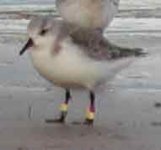Rufus
Bristlebirdwatcher
Draco's item about Peregrines on the roof prompted me to think how rarely I have heard of people reading band (in Pommiespeak that's ring) numbers in the field. Most recoveries are found dead or retrapped by banders who read the number in the hand.
I wonder if any BF birders have tales to tell or tips to share on reading band numbers? I remember years ago reading in a BTO publication of someone luring Black-headed Gulls close by feeding them in a London park and reading band numbers, through binocs if I remember rightly.
My own single success in many years of birdwatching was with a White-breasted Sea-eagle (Haliaeetus leucogaster) perched on a power pole not far north of Adelaide, South Australia. That bird had been banded in the nest on Kangaroo Island.
Rufus
I wonder if any BF birders have tales to tell or tips to share on reading band numbers? I remember years ago reading in a BTO publication of someone luring Black-headed Gulls close by feeding them in a London park and reading band numbers, through binocs if I remember rightly.
My own single success in many years of birdwatching was with a White-breasted Sea-eagle (Haliaeetus leucogaster) perched on a power pole not far north of Adelaide, South Australia. That bird had been banded in the nest on Kangaroo Island.
Rufus





